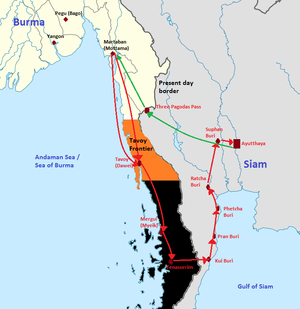Siamese-Burmese War 1759–1760
| date | 1759 to 1760 |
|---|---|
| place | Siam |
| Casus Belli | Longstanding rivalry between Burma and Siam |
| output | Burma invaded Siam, but withdrew after the king's death |
| Parties to the conflict | |
|---|---|
| Commander | |
|
King Ekathat of Ayutthaya |
King Alaungpaya of Burma |
| Troop strength | |
| about 20,000 men | probably a force of the same size as Siam |
| losses | |
|
unknown |
unknown |
The Siamese-Burmese War 1759-1760 ( Thai สงคราม พระเจ้า อ ลอง พญา , Songkhram Phrachao Alongphaya , "King Alaungpaya's War") was a military confrontation between the Burma of the Konbaung dynasty under King Alaungpaya and the Kingdom of Ayutthaya under Ekathat .
prehistory
The Taungu dynasty , which ruled from Ava , lost its control over Burma in the mid-18th century and its sphere of influence was divided into many small states. The Mon declared their kingdom of Pegu independent again in 1740 , conquered Ava in 1752, captured the last Taungu king and eventually killed him. The local prince Alaungpaya from Moksobo ( Shwebo ) in Upper Burma succeeded in conquering the most important small empires, such as Yangon and Pegu, by 1757 and thus reuniting Burma. He founded the Konbaung dynasty and is considered the greatest military leader in the history of Burma.
In 1759 there was a rebellion in Negrais and Alaungpaya suspected Ayutthaya to have played a role in the background. In addition, Mon leaders had fled to Ayutthaya after the annexation of their capital through Alaungpaya. From there, possibly with the assistance of the Siamese king, they prepared their return and reestablishment of their empire. Alaungpaya, who was a legendary warlord but was completely inexperienced as a leader, probably feared that in peacetime there might be a struggle for independence in his newly assembled empire. As long as the war raged, however, he could rely on his vassal states to stand united behind his charismatic rule.
Another reason for the war was the labor shortage. After almost twenty years of war between the individual Burmese rulers ("Burmese civil war"), the country was largely depopulated. In pre-modern Southeast Asia, which was already sparsely populated, the aim of the war was usually not the conquest of territories (which, due to the lack of a developed administrative system, could not be permanently controlled), but rather the capture of workers who were then dragged into their own sphere of influence. Alaungpaya therefore probably hoped to increase the labor base in his empire with "captured" Siamese subjects.
course
Initially, 20,000 Siamese went to the Tenasserim Peninsula to take the important port city of Tavoy . They were repulsed and Alaungpaya took the opportunity to take direct action against Ayutthaya. In April 1760 he marched with his force against Ayutthaya and besieged the capital. According to the Chronicles of Ayutthaya , the Burmese brought their large cannons into position and fired at the "Holy Metropolis", destroying buildings and killing people. One evening they retired to Wat Phu Khao Thong . The following morning - the first day of the waxing moon in the sixth month of the year of the dragon - they positioned their cannons and fired at the "Holy Royal Palace" ( Wang Luang ) throughout the day and the following night . On the morning of the second day, the Burmese suddenly retreated north because King Alaungpaya had fired one of the large cannons himself, but it exploded and injured the king so badly that he died while retreating at the age of 46.
consequences
The Burmese had recognized that the military power of Ayutthaya was relatively weak and consequently pondered the complete conquest of the old enemy. The next Burmese invasion of Siam began as early as 1763 ( Siamese-Burmese War 1764–1769 ).
Individual evidence
- ↑ Damrong Rajanubhab: Rueang thai rop phama khrang krung kao. 1917 (English: Our Wars with the Burmese. Thai-Burmese conflict 1539-1767. Translated and edited by Chris Baker . White Lotus, Bangkok 2001, ISBN 9747534584 , pp. 240-311.)
- ^ David K. Wyatt: Thailand. A short history. 2nd edition, Silkworm Books, Chiang Mai 2003, p. 116.
- ^ Richard D. Cushman (David K. Wyatt Ed.): The Royal Chronicles Of Ayutthaya . The Siam Society, Bangkok 2000, ISBN 974-8298-48-5
literature
- Charles Phillips and Alan Axelrod: Encyclopedia of Wars . 3 Vols. New York: Facts on File 2004. ISBN 9780816028511 .
